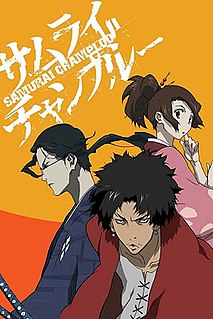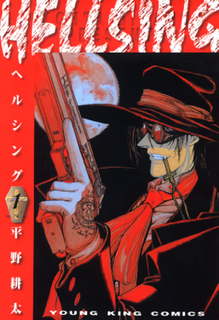Related Research Articles
Anime is hand-drawn and computer animation originating from Japan. In Japan and in Japanese, anime describes all animated works, regardless of style or origin. However, outside of Japan and in English, anime is colloquial for Japanese animation and refers specifically to animation produced in Japan. Animation produced outside of Japan with similar style to Japanese animation is referred to as anime-influenced animation.

Neon Genesis Evangelion is a Japanese mecha anime television series produced by Gainax and animated by Tatsunoko, directed by Hideaki Anno and broadcast on TV Tokyo from October 1995 to March 1996. Evangelion is set fifteen years after a worldwide cataclysm, particularly in the futuristic fortified city of Tokyo-3. The protagonist is Shinji Ikari, a teenage boy who was recruited by his father Gendo to the shadowy organization Nerv to pilot a giant bio-machine mecha named "Evangelion" into combat against beings known as "Angels". The series explores the experiences and emotions of Evangelion pilots and members of Nerv as they try to prevent Angels from causing more cataclysms. In the process, they are called upon to understand the ultimate causes of events and the motives for human action. The series has been described as a deconstruction of the mecha genre and it features archetypal imagery derived from Shinto cosmology as well as Jewish and Christian mystical traditions, including Midrashic tales and Kabbalah. The psychoanalytic accounts of human behavior put forward by Freud and Jung are also prominently featured.
Original video animation, abbreviated as OVA and sometimes as OAV, are Japanese animated films and series made specially for release in home video formats without prior showings on television or in theaters, though the first part of an OVA series may be broadcast for promotional purposes. OVA titles were originally made available on VHS, later becoming more popular on LaserDisc and eventually DVD. Starting in 2008, the term OAD began to refer to DVD releases published bundled with their source-material manga.

Fruits Basket, sometimes abbreviated Furuba or Fruba (フルバ), is a Japanese manga series written and illustrated by Natsuki Takaya. It was serialized in the semi-monthly Japanese shōjo manga magazine Hana to Yume, published by Hakusensha, from 1998 to 2006. The series' title comes from the name of a popular game played in Japanese elementary schools, which is alluded to in the series.

FLCL is an original video animation (OVA) anime series created and directed by Kazuya Tsurumaki, written by Yōji Enokido, and produced by the FLCL Production Committee, which consisted of Gainax, Production I.G, and King Records. FLCL is a story following Naota Nandaba, a twelve-year-old boy whose suburban life is disturbed by the arrival of the mysterious Haruko Haruhara.

Naruto is a Japanese manga series written and illustrated by Masashi Kishimoto. It tells the story of Naruto Uzumaki, a young ninja who seeks recognition from his peers and dreams of becoming the Hokage, the leader of his village. The story is told in two parts – the first set in Naruto's pre-teen years, and the second in his teens. The series is based on two one-shot manga by Kishimoto: Karakuri (1995), which earned Kishimoto an honorable mention in Shueisha's monthly Hop Step Award the following year, and Naruto (1997).

Samurai Champloo is a 2004 Japanese anime television series. The debut television production of studio Manglobe, the 26-episode series aired between May 2004 and March 2005. It was first partially broadcast on Fuji TV, then had a complete airing on Fuji Network System. It was licensed for North American broadcast on Adult Swim, and for commercial release first by Geneon Entertainment and later by Funimation. It was also licensed for English releases in the United Kingdom by MVM Films, and in Australia and New Zealand by Madman Entertainment. A manga adaptation was serialized in Monthly Shōnen Ace during 2004, later released in North America by Tokyopop the following year.

Hajime no Ippo is a Japanese boxing-themed manga series written and illustrated by George Morikawa. It has been serialized by Kodansha in Weekly Shōnen Magazine since October 1989 and collected into 133 tankōbon volumes as of December 2021. It follows the story of high school student Makunouchi Ippo, as he begins his career in boxing and over time obtains many titles and defeats various opponents.

Bobobo-bo Bo-bobo is a Japanese comedy manga series written and illustrated by Yoshio Sawai. It was serialized in Shueisha's shōnen manga magazine Weekly Shōnen Jump from February 2001 to November 2005. It was followed by a sequel titled Shinsetsu Bobobo-bo Bo-bobo, serialized from December 2005 to July 2007. A 76-episode anime television series adaptation by Toei Animation was broadcast on TV Asahi from November 2003 to October 2005. In North America, Viz Media published some volumes of the manga. The anime series aired in the United States on Cartoon Network from 2005 to 2007. As of January 2021, the Bobobo-bo Bo-bobo manga had over 7 million copies in circulation.

Bleach is a Japanese anime television series based on Tite Kubo's original manga series of the same name. It was produced by Studio Pierrot and directed by Noriyuki Abe. The series aired on TV Tokyo from October 2004 to March 2012, spanning 366 episodes. The story follows the adventures of Ichigo Kurosaki after he obtains the powers of a Soul Reaper—a death personification similar to the Grim Reaper—from another Soul Reaper, Rukia Kuchiki. His newfound powers force him to take on the duties of defending humans from evil spirits and guiding departed souls to the afterlife. The anime adaptation includes original storylines not found in the manga with repeated appearances and stories containing these original characters.

Black Lagoon is a Japanese manga series written and illustrated by Rei Hiroe. It has been published in Shogakukan's seinen manga magazine Monthly Sunday Gene-X since 2002, and twelve collected volumes have been released as of August 2021.

Code Geass: Lelouch of the Rebellion, often referred to simply as Code Geass, is a Japanese anime television series produced by Sunrise. It was directed by Gorō Taniguchi and written by Ichirō Ōkouchi, with original character designs by Clamp. Set in an alternate timeline, it follows the exiled prince Lelouch vi Britannia, who obtains the "power of absolute obedience" from a mysterious woman named C.C. Using this supernatural power, known as Geass, he leads a rebellion against the rule of the Holy Britannian Empire, commanding a series of mecha battles.

Hellsing is a Japanese manga series written and illustrated by Kouta Hirano. It was serialized in Young King OURs from May 1997 to September 2008. The series chronicles the efforts of the mysterious and secret Hellsing Organization as it combats vampires, ghouls, and other supernatural foes who threaten England. The individual chapters were subsequently collected and published in 10 tankōbon volumes by Shōnen Gahōsha. The series was licensed for English language release in North America by Dark Horse Comics. From 2001 to 2009, Hirano released a 6-chapter prequel series, Hellsing: The Dawn, in special editions of Young King OURs.

Gin Tama is a Japanese manga series written and illustrated by Hideaki Sorachi. Set in Edo, which has been conquered by aliens named Amanto, the plot follows life from the point of view of samurai Gintoki Sakata, who works as a freelancer alongside his friends Shinpachi Shimura and Kagura to pay the monthly rent. Sorachi added the science fiction setting to develop characters to his liking after his editor suggested doing a historical series. It was serialized in Shueisha's Weekly Shōnen Jump from December 2003 to September 2018, later in Jump GIGA from December 2018 to February 2019, and finished on the Gin Tama app in May and June 2019.

Haruhi Suzumiya is a Japanese light novel series written by Nagaru Tanigawa and illustrated by Noizi Ito. It was first published in 2003 by Kadokawa Shoten in Japan with the novel The Melancholy of Haruhi Suzumiya, and has since been followed by 11 additional novel volumes, an anime television series adaptation produced by Kyoto Animation, four manga series, an animated film, two original net animation series and several video games.

Shugo Chara!, also known as My Guardian Characters, is a Japanese shōjo manga series created by the manga author duo, Peach-Pit. The story centers on elementary school girl Amu Hinamori, whose popular exterior, referred to as "cool and spicy" by her classmates, contrasts with her introverted personality. When Amu wishes for the courage to be reborn as her would-be self, she is surprised to find three colorful eggs the next morning, which hatch into three Guardian Characters: Ran, Miki, and Su.

One Piece is a Japanese anime television series produced by Toei Animation that premiered on Fuji TV in October 1999. It is based on Eiichiro Oda's manga series of the same name. The story follows the adventures of Monkey D. Luffy, a boy whose body gained the properties of rubber after unintentionally eating a Devil Fruit. With his crew of pirates, named the Straw Hat Pirates, Luffy explores the Grand Line in search of the world's ultimate treasure known as "One Piece" in order to become the next Pirate King.
References
- ↑ ストーリー [Story] (in Japanese). Geneon Universal Entertainment. Archived from the original on November 21, 2012. Retrieved May 31, 2013.